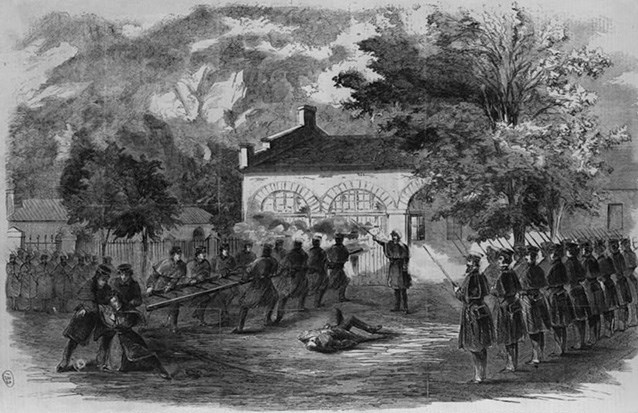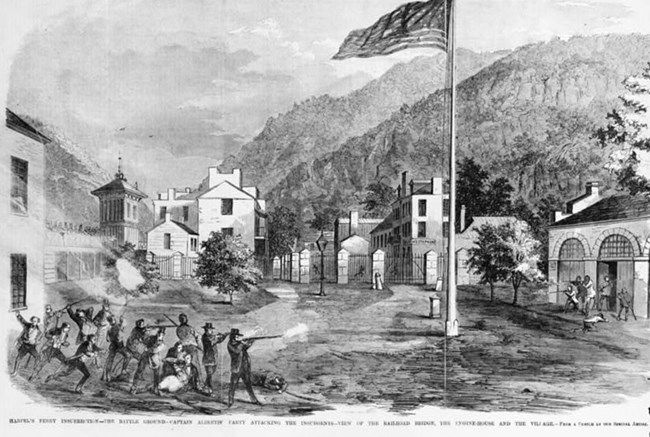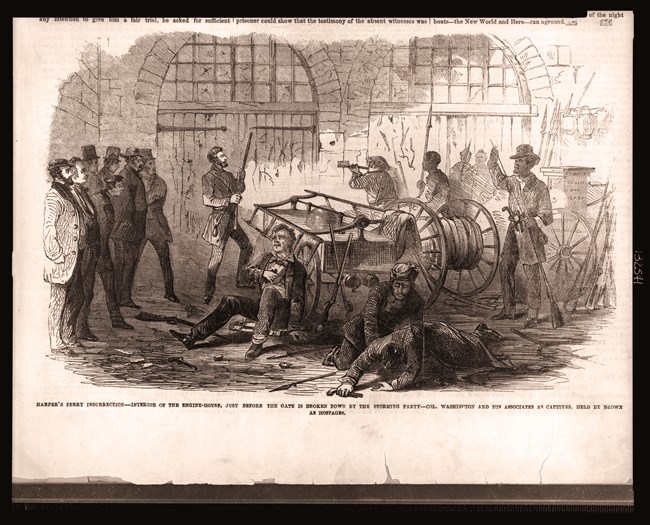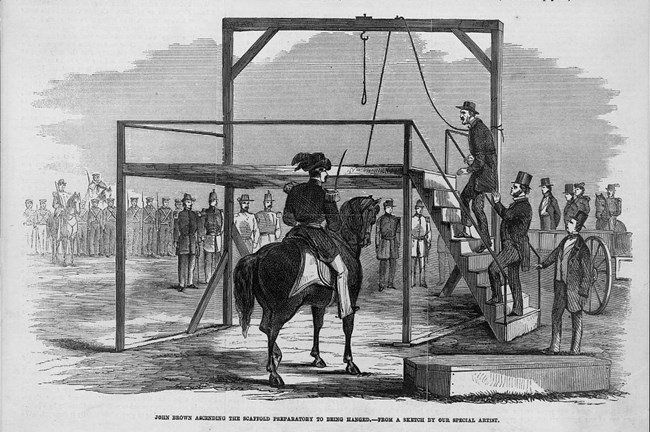"Slavery is a state of war." John Brown
Article
John Brown's Raid

Frank Leslie's Illustrated Newspaper; Library of Congress
Preparing for War
On July 3, 1859, Brown arrived in Harpers Ferry, accompanied by his sons, Oliver and Owen, and Jeremiah Anderson. In the preceding months, Brown raised money from other abolitionists and ordered weapons — pikes and guns — to be used in his war against slavery. Using the alias Isaac Smith, Brown rented the Kennedy Farm about five miles from Harpers Ferry, on the Maryland side of the Potomac River. Throughout the summer Brown's Army gathered at the farmhouse. Numbering twenty-one at the time of the raid, these men stayed hidden in the attic by day, reading, writing letters, polishing their rifles and playing checkers. To avoid being seen by curious neighbors, they could only come out at night. To keep up the appearance of a normal household, Brown sent for his daughter, 15-year-old Annie, and Oliver's wife, 17-year-old Martha. The teens prepared meals, washed clothes and kept nosy neighbors at a distance. Brown studied maps and conferred with John Cook (his advance man in Harpers Ferry) about the town, armory operations, train schedules and any other information deemed valuable to his plan. On September 30, Brown sent Martha and Annie home to New York. The time was near. On Sunday, October 16, Brown called his men together. Following a prayer, he outlined his battle plans and instructed them, "Men get on your arms; we will proceed to the Ferry."Striking a Blow for Freedom
October 16, 1859- 8:00 pm Brown and 18 of his men advance towards Harpers Ferry.
- 10:00 pm The men take both bridges, the U.S. Armory and Arsenal and the U.S. Rifle Works on Hall's Island.
- 12:00 am Enslavers Lewis Washington and John Allstadt are taken hostage and the people they enslaved are freed.
I came here from Kansas and this is a slave state; I want to free all the negroes in this state; I have possession now of the United States armory, and if the citizens interfere with me, I must only burn the town and have blood. John Brown to the armory watchman

Frank Leslie's Illustrated Newspaper; Library of Congress
- 1:25 am A Baltimore & Ohio passenger train stops at the bridge. Heyward Shepherd, a free African American and railroad employee, is shot and mortally wounded as he investigates the train's delay.
- 4 - 5 am Hostages are held in the Armory fire engine house.
- Daylight Messengers carry the alarm of slave revolt to nearby towns. Brown seizes armory employees as they report to work.
- 7:00 am Townspeople begin firing on the raiders. Groceryman Thomas Boerly is killed by return fire.
- 10:00 am Local militia units take positions surrounding Brown's men, cutting off escape routes. Dangerfield Newby is shot - the raider to die. Raider William Thompson is captured under a white flag when Brown asks for a truce.
Dear Husband, Master is in want of money ... he may sell me ... come this fall money or no money. Harriet Newby, enslaved person, in a letter to her husband, Dangerfield Newby
- Noon Raiders Watson Brown and Aaron Stevens are shot while carrying a second flag of truce.
- 1:00 pm Raider William Leeman is killed as he attempts to escape across the Potomac River.
- 2:00 pm Citizens storm the U.S. Rifle Works. Raider John Kagi and Jim — a formerly enslaved person — are killed and Raider Lewis Leary is mortally wounded as they try to escape across the Shenandoah River. Raider John Copeland and Ben — a formerly enslaved person — are captured. At the Armory, Fontaine Beckham, mayor of Harpers Ferry, is shot and killed as he ventures, unarmed, too close to the fighting. A drunken mob, enraged by the mayor's death, murders William Thompson and tosses his body into the Potomac River.
- 3:00 pm At the Armory, militiamen free most of the hostages and force Brown and his men into the engine house.
- Dark Hundreds of excited militiamen and townspeople jam the streets of Harpers Ferry. Raiders Albert Hazlett and Osborne Anderson, overlooked by townspeople, leave the Arsenal and escape across the Potomac River. Raider Stewart Taylor is shot and killed. Raiders Owen Brown, John Cook, Barclay Coppoc, Francis Meriam, and Charles Tidd, guarding supplies in Maryland, escape into the hills.
- 11:00 pm Colonel Robert E. Lee and 90 U.S. Marines arrive by train from Washington, D.C.
But for fear of sacrificing the lives of some of the gentlemen held by them as prisoners in a midnight assault, I should have ordered the attack at once. Col. Robert E. Lee

Frank Leslie's illustrated newspaper; Library of Congress
- Early Oliver Brown dies.
- 7:00 am Brown refuses to surrender to Lt. J.E.B. Stuart. A Marine storming party breaks into the engine house. One Marine is killed and another wounded. Lt. Israel Green beats Brown with his sword. Raiders Dauphin Thompson and Jeremiah Anderson are killed. Raiders Edwin Coppoc and Shields Green surrender. Wounded raiders Aaron Stevens and Watson Brown are captured. No hostages are injured. Watson Brown dies the next day.
If you die, you die in a good cause, fighting for liberty. If you must die, die like a man. John Brown to his son, Oliver

Frank Leslie's illustrated newspaper; Library of Congress
The Aftermath
Sixteen people were killed in the raid, including ten of Brown's men.John Brown, Aaron Stevens, Edwin Coppoc, Shields Green, and John Copeland were taken to jail in Charles Town, Virginia, on October 19. Albert Hazlett and John Cook were subsequently captured and jailed with the others.
Faced with charges of murder, conspiring with enslaved people to rebel and treason against the state of Virginia, John Brown's trial began October 27 and lasted just five days. Jurors took only 45 minuts to reach a decision — guilty of all charges. On November 2 Brown was sentenced to hang on the gallows. All six of Brown's captured men were tried and hanged. Five escaped.
Brown was executed December 2, 1859. Brown's wife, Mary, took his body home to North Elba, New York, for burial.
A contemporary newspaper account foretold a grim future. "The Harpers Ferry invasion has advanced the cause of disunion more than any other event that has happened since the formation of the Government."
Hope of compromise between the North and South slipped. Civil War seemed inevitable.
I, John Brown, am now quite certain that the crimes of this guilty land will never be purged away but with blood. I had, as I now think, vainly flattered myself that without very much bloodshed it might be done. John Brown, December 2, 1859
Last updated: March 5, 2024
